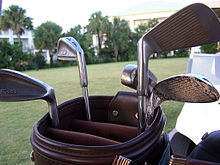
By Alan Prescott
May 26, 2021
In my last article, I promised to write about the custom golf club market and how it changed the golf club manufacturing landscape. To be considerate of the changes that have occurred and the people, who I mentioned in my previous article, this discussion begins at the outset. Hopefully, nothing and no one will be eliminated, even accidentally.
What are “custom” golf clubs? One definition is certainly those clubs, that are made to “fit” the physical traits as well as the playing ability of a particular golfer. Some of the parameters are as follows:
1. Club length
2. Clubhead type – forged or cast
3. Clubhead material – 17-4 or 431 stainless steel
4. Clubhead Lie – how it rests on the ground
5. Clubhead Loft – the angle that the clubhead allows the golf ball to launch at
6. Grip material
7. Grip size or thickness
8. Shaft material – steel, graphite, titanium, aluminum, or wood
9. Clubhead style – muscle back or perimeter-weighted
10. Golf shaft flex point
11. Shaft, grip, and head weights – are important considerations in the manufacture of golf clubs.
Custom golf clubs must fit the player’s physical attributes, especially when they’re “customized” to fit a disabled player. Wounded warriors, people with amputated limbs, and other special disabilities, such as blind golfers, are NEVER eliminated from the right to own their own set of custom-fitted golf clubs in my golf shop. It has ALWAYS been a credo of the successful golf club fitter to help those golfers or potential golfers to maximize their experience, no matter what is required.
Custom-fitted golf clubs have been a staple of the golf industry for several decades. When the average golfer relies on a club-fitter to make the correct set of clubs, the result is frequently disappointment. When major golf club manufacturers first coined and advertised the words “custom-fitted” to described their brand’s ability, the only custom-fitting was just different lengths of golf clubs. In their defense, the golf club world didn’t have the correct materials to provide the different aspects at that time. Most golf club components, such as clubheads for example, were made of materials that were very rigid and would break when an attempt was made to bend them to fit the golfer.
However, with the development of different and more flexible clubhead materials, custom golf clubs advanced to allow for more accurate and inclusive clubhead fittings. Todays golf clubs from major manufacturers are much better, except for those made by the Taylor Made Company. In my decades of repairing golf clubs, these golf clubs have been found to not match each other in the same set. Every set does have some minute differences because they are made by humans, for the most part. When robotics enter into the picture, golf club manufacturing will change once more.
Let’s discuss the club-fitter. I have spent over 40 years studying and applying the learned techniques of golf club manufacture. In my last article, the names of those individuals, who were instrumental in the development and improvement of the playability of golf clubs were my mentors for years. For years, I experimented with different materials and types of golf clubs by testing and retesting the various components and giving feedback to help in the development of both golf clubs (as well as golf balls).
By comparison, when you walk into Big Box Golf Shops, such as Dick’s Sporting Goods or Golf Galaxy (also owned by Dick’s Sporting Goods, which in addition, owns Ralph Maltby Golfworks through acquisition), you are distracted from their lack of club-fitting knowledge and capability by the size of their inventory as well as their expensive “Golf Analyzers”, which are nothing but tools that their incompetent staff “club-fitting imposters”, who are lucky to be able to tell the difference between a clubhead, a golf shaft, and a golf grip, use to mask the club-fitting inabilities. In sum, you have more chance of being run over by a camel right where you’re standing while reading this article than you are to purchase a truly “custom-fitted” set of golf clubs at any of these off-course golf shops. In addition, there are “open-air facilities”, such as the one that is located less than a mile from my residence, which are also “club-fitting” imposters, even though they own a golf driving range.
Let the buyer beware!!!
In my next article, John continues in his efforts to earn his degree in the “School of the Business of Golf”. It begins with a brief summary of his last course while describing the second-to last course on his journey toward earning his degree of a “Master of the Business of Golf”.
As always, I am Alan Prescott and I can be reached for comments and your suggestions at [email protected].
Please be safe and stay healthy.
Editor’s Note: Alan Prescott reached out to us after reading a recent article on the Fernandina Beach Golf Course. His articles are being well received by golfers and non-golfers. We thank Alan for his contribution to the Fernandina Observer.

Some of the things this guy says is flat out wrong. Forged clubs have been around for many decades and are very easy to bend for lie angle. In addition, Ping was one of the first “customizable” retail club because of their colored dot lie angle options, not because of club length options. Also, different cast metal club heads isn’t really a customization feature. It makes no significant difference in club playability. This article sounds like something written in the 1950’s.
I totally agree….seems like this guy wrote an article about everything he had heard from his friends or maybe watched a YouTube video or two…..I’ve been in the custom club fitting business since the early 90’s and I know I could write a more detailed article….